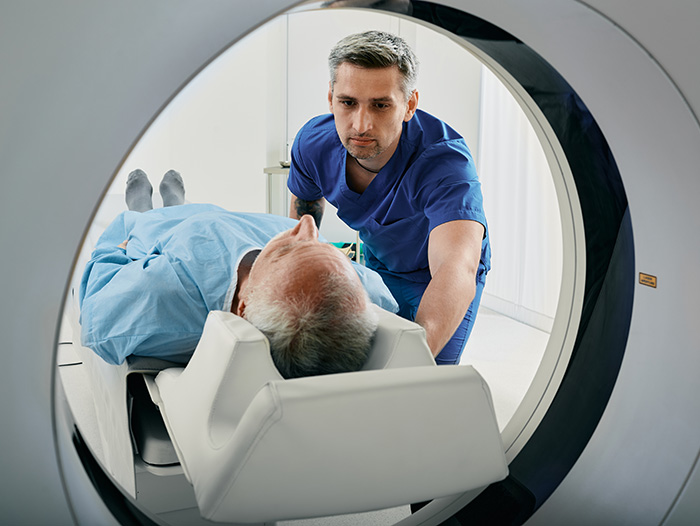A tiny spot on Ben Murray's nose set him on a journey through a number of conflicting diagnoses and uncertain treatments, until a shocking answer changed his life forever, Sandra Boodman reports for the Washington Post.
A small spot on the nose
A pea-sized spot near the tip of 42-year-old Murray's nose seemed harmless when it first felt numb.
In March 2020, Murray was working as a videographer for the Military Times and, amid the early throes of the COVID-19 pandemic, found his focus elsewhere — his wife, Rebecca, was pregnant with their first child.
For several months, Murray periodically touched the spot on his nose, which appeared unchanged. "[I decided it] was something weird that would go away on its own," Murray recalled.
By August 2020, the numbness had spread, the area around his nose had reddened, and it had once bled without warning. In September, a month after Murray's son was born, he visited a dermatologist — one of six doctors he would see over the next several months.
Murray received an initial diagnosis of rosacea, a chronic skin condition that causes redness on the nose and cheeks, and was prescribed a series of creams that failed to help.
Unsatisfied, Murray turned to a primary care doctor in December 2020 and was then referred to an ear, nose, and throat (ENT) specialist. The ENT ordered blood tests and diagnosed Murray with a staph infection, prescribing an additional series of creams. Still, the numbness and redness persisted.
A CT scan soon revealed chronic sinusitis, prompting discussions of sinus surgery to relieve possible nerve pressure. Yet, uncertainty around the best treatment path led to further opinions and another round of creams from a second ENT before a biopsy was performed in April 2021.
A shocking answer, and challenging treatment options
Days after the biopsy, Murray learned that he had skin cancer, though the specific type was unclear.
Pathologists and specialists in dermatologic oncology eventually determined that his cancer was an extremely rare form: squamoid eccrine ductal carcinoma (SEDC), an aggressive cancer of the sweat glands that shares features with squamous cell carcinoma.
As first described in 1997, SEDC is typically found on the head or neck and has been reported in only a few hundred people worldwide, mostly in men ages 70 and older.
"This is one of those diagnoses that if you don't have it in the back of your mind," you're probably not going to make it because it's so rare, said surgical oncologist Michael Lowe, an associate professor at Emory University School of Medicine who specializes in complex skin cancer treatment.
After consultations in Northern Virginia, Baltimore, and Cleveland, Murray's treatment options narrowed.
Genetic testing ruled out the likely effectiveness of immunotherapy, and radiation alone was predicted to be insufficient. Mohs surgery, a procedure to remove cancer layer by layer, was not expected to help, either.
Doctors recommended a rhinectomy — removal of part or all of Murray's nose — followed by six weeks of radiation and a series of reconstructive surgeries expected to last a total of nearly 18 months.
After initially refusing treatment he deemed "medieval," Murray, a new father who wanted to see his son grow up, chose the drastic operation.
related resources
- Have a medical mystery? AI could help with that.
- 3 strategies to harness the value of genetic testing
- 6 questions shaping the future of oncology screening and diagnostics
- Nine innovative strategies to improve cancer screening
- Cancer screening program resource library
- 5 ways to protect yourself from 'medical gaslighting'
Surgery and recovery
In July of 2021, Murray underwent an outpatient rhinectomy. While in the recovery room, Murray asked his wife if any of his nose remained. While the answer was no, the pathology report revealed that the surrounding margins were free of cancer cells.
A month later, Murray began radiation treatment, which was administered five days a week for six weeks. Although initial treatment plans called for six reconstructive operations over 18 months, Murray has now undergone 18 surgeries over the course of three and a half years, with doctors hoping to complete the process this year.
A major complicating factor was Murray's malignant hyperthermia — a rare genetic condition that triggers dangerous reactions to certain anesthesia drugs — a condition discovered after an emergency appendectomy at age 17.
Additionally, damage from radiation may have complicated the reconstruction, and in summer of 2022, Johns Hopkins surgeons found that the tissue and cartilage used to form a new nose had collapsed and been resorbed, forcing them to start over.
Beyond the physical toll, Murray described the emotional challenge of coping with profound isolation and a radically altered appearance.
"It was way harder in the beginning," Murray said, noting that the change "really kind of cripples you for a bit." His wife and family have been an "unshakable presence" throughout his ordeal.
Murray chronicled his journey in a series of candid pieces on Medium. The experience also inspired him to start the Rhinectomy Support Network, a website and support group designed to help others facing similar challenges.
"The mental aspect of this particular disfigurement is tough," Murray said. "Very few people have it. I still look kind of funny and am not unaffected by it."
Lowe underscored the importance of psychological support in recovery.
Psychological support and home care "are all parts of a patient's care," Lowe said, adding that it's important for people who have undergone a rhinectomy "to know you are not alone, that there's someone else out there who's going through what you've gone through."
(Boodman, Washington Post, 1/25)
Don't miss out on the latest Advisory Board insights
Create your free account to access 1 resource, including the latest research and webinars.
Want access without creating an account?
You have 1 free members-only resource remaining this month.
1 free members-only resources remaining
1 free members-only resources remaining
You've reached your limit of free insights
Become a member to access all of Advisory Board's resources, events, and experts
Never miss out on the latest innovative health care content tailored to you.
Benefits include:
You've reached your limit of free insights
Become a member to access all of Advisory Board's resources, events, and experts
Never miss out on the latest innovative health care content tailored to you.
Benefits include:
This content is available through your Curated Research partnership with Advisory Board. Click on ‘view this resource’ to read the full piece
Email ask@advisory.com to learn more
Click on ‘Become a Member’ to learn about the benefits of a Full-Access partnership with Advisory Board
Never miss out on the latest innovative health care content tailored to you.
Benefits Include:
This is for members only. Learn more.
Click on ‘Become a Member’ to learn about the benefits of a Full-Access partnership with Advisory Board
Never miss out on the latest innovative health care content tailored to you.




